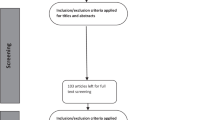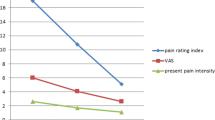Abstract
Myofascial pain syndrome (MPS) is a very common disease in the population that seriously affects quality of life. Although many treatment modalities are used, there is still no common protocol. The aim of this study was to compare the effectiveness of high-intensity laser therapy (HILT) and dry needling options. This prospective study included 108 patients with neck and/or upper back pain, diagnosed with MPS, who were randomly separated into 3 groups: the exercise group, the exercise + HILT group (HILT group), and the exercise + dry needling group (needling group). The visual analog scale (VAS), neck disability index (NDI), short form-36 (SF-36) scores, and neck range of motion (ROM) values of the patients before and after treatment were recorded and compared between the groups. In all 3 groups, the VAS and NDI scores decreased and ROM levels increased after treatment. The results in the HILT and needling groups were statistically significantly better than those of the exercise group (p < 0.05).The addition of HILT and dry needling to exercises is seen as a more successful treatment option to reduce pain in MPS. Clinical trial registration number: NCT05078333.

Similar content being viewed by others
References
Cummings M, Baldry P (2007) Regional myofascial pain: diagnosis and management. Best Pract Res Clin Rheumatol 21(2):367–387
Gerwin RD (1995) A study of 96 subjects examined both for fibromyalgia and myofascial pain. J Musculoskel Pain 3(supplement 1):121
Fishbain DA, Goldberg M, Meagher BR et al (1986) Male and female chronic pain patients categorized by DSM-III psychiatric diagnostic criteria. Pain 26:181e197
Simons DG, Travell JG, Simons PT (1999) Myofascial pain and dysfunction: the trigger point manual. Lippincott Williams & Wilkins, Philadelphia
Cummings TM, White AR (2001) Needling therapies in the management of myofascial trigger point pain: a systematic review. Archi Phys Med Rehabil 82:986992
Liu L, Huang QM, Liu QG, Thitham N, Li LH, Ma YT, Zhao JM (2018) Evidence for dry needling in the management of myofascial trigger points associated with low back pain: a systematic review and meta-analysis. Arch Phys Med Rehabil 99(1):144–152
Majlesi J, Unalan H (2004) High-power pain threshold ultrasound technique in the treatment of active myofascial trigger points: a randomized, double-blind, case-control study. Arch Phys Med Rehabil 85:833e836
Song HJ, Seo HJ, Lee Y, Kim SK (2018) Effectiveness of high-intensity laser therapy in the treatment of musculoskeletal disorders: a systematic review and meta-analysis of randomized controlled trials. Med (Baltimore) 97(51):e13126
Ezzati K, Laakso EL, Salari A, Hasannejad A, Fekrazad R, Aris A (2020) The beneficial effects of high-intensity laser therapy and co-interventions on musculoskeletal pain management: a systematic review. J Lasers Med Sci 11(1):81–90
Dundar U, Turkmen U, Toktas H, Solak O, Ulasli AM (2015) Effect of high-intensity laser therapy in the management of myofascial pain syndrome of the trapezius: a double-blind, placebo-controlled study. Lasers Med Sci 30(1):325–332
Ahmed HM, AbuTaleb Ameen EFH (2020) High intensity laser therapy on pain in patients with myofascial trigger points. Egypt J Phys Ther 3:1–8
Zati A, Valent A (2006) Physical therapy: new technologies in rehabilitation medicine (translated to English). Edizioni Minerva Medica 162–85.
Price DD, McGrath PA, Rafii A, Buckingham B (1983) The validation of visual analogue scales as ratio scale measures for chronic and experimental pain. Pain 17(1):45–56
Kesiktas N, Ozcan E, Vernon H (2012) Clinimetric properties of the Turkish translation of a modified neck disability index. BMC Musculoskelet Disord 21(13):25
Demiral Y, Ergor G, Unal B, Semin S, Akvardar Y, Kivircik B et al (2006) Normative data and discriminative properties of short form 36 (SF-36) in Turkish urban population. BMC Public Health 9(6):247
Mata Diz JB, de Souza J, Leopoldino AAO, Oliveira VC (2017) Exercise, especially combined stretching and strengthening exercise, reduces myofascial pain: a systematic review. J Physiother 63(1):17–22
US Department of Health and Human Services (2018) Physical activity guidelines for Americans, 2nd edn. US Department of Health and Human Services, Washington, DC
Hakgüder A, Birtane M, Gürcan S, Kokino S, Turan FN (2003) Efficacy of low level laser therapy in myofascial pain syndrome: an algometric and thermographic evaluation. Lasers Surg Med 33(5):339–343. https://doi.org/10.1002/lsm.10241
Ohshiro T, Calderhead R (1991) Development of low reactive-level laser therapy and its present status. J Clin Laser Med Surg 9:267–275
Santamato A, Solfrizzi V, Panza F, Tondi G, Frisardi V, Leggin BG, Ranieri M, Fiore P (2009) Short-term effects of high-intensity laser therapy versus ultrasound therapy in the treatment of people with subacromial impingement syndrome: a randomized clinical trial. Phys Ther 89:643–652
Boyraz İ, Yıldız A (2017) Lazer Çeşitleri ve yüksek yoğunluklu lazer kullanımı. Çağdaş Tıp Dergisi, 6(1-Ek (Olgu Sunumları)) 104–109
Zati AFD, Valent A (2004) High intensity laser therapy versus TENS and NSAIDs in low back pain: clinical study. SPIE Proceed 5610:277–278
Navarro-Santana MJ, Sanchez-Infante J, Fernández-de-Las-Peñas C, Cleland JA, Martín-Casas P, Plaza-Manzano G (2020) Effectiveness of dry needling for myofascial trigger points associated with neck pain symptoms: an updated systematic review and meta-analysis. J Clin Med 9(10):3300
Oh SH, Yoo KT (2016) The effects of stabilization exercises using a sling and stretching on the range of motion and cervical alignment of straight neck patients. J Phys Ther Sci 28(2):372–377
Jeon HY, Lee SY, Bae SS et al (2009) Effect of stretching exercise on cervical ROM in elderly. J Korean Soc Phys Med 4:57–62
Alfawaz S, Lohman E, Alameri M, Daher N, Jaber H (2020) Effect of adding stretching to standardized procedures on cervical range of motion, pain, and disability in patients with non-specific mechanical neck pain: a randomized clinical trial. J Bodyw Mov Ther 24(3):50–58
Blomgren J, Strandell E, Jull G, Vikman I, Röijezon U (2018) Effects of deep cervical flexor training on impaired physiological functions associated with chronic neck pain: a systematic review. BMC Musculoskelet Disord 19(1):415
Ilbuldu E, Cakmak A, Disci R, Aydin R (2004) Comparison of laser, dry needling, and placebo laser treatments in myofascial pain syndrome. Photomed Laser Surg 22:306–311
Perreault T, Dunning J, Butts R (2017) The local twitch response during trigger point dry needling: is it necessary for successful outcomes? J Bodyw Mov Ther 21(4):940–947
Kiralp MZ, Ari H, Karabekir I et al (2006) Comparison of low intensity laser therapy and trigger point injection in the management of myofascial pain syndrome. Pain Clin 18:63–66
Uemoto L, Garcia MAC, Alfaya TA et al (2013) Laser therapy and needling in myofascial trigger point deactivation. J Oral Sci 55(2):175–181
Uemoto L, Nascimento de Azevedo R, Almeida Alfaya T, NunesJardim Reis R, Depes de Gouvêa CV, Cavalcanti Garcia MA (2013) Myofascial trigger point therapy: laser therapy and dry needling. Curr Pain Headache Rep 17(9):357
Author information
Authors and Affiliations
Contributions
EDA contributed to the study design, data collection, interpretation of the data, and writing and revising the manuscript and accepted responsibility for the corresponding author.
HS contributed to the data collection, data interpretation, and revising and editing of the manuscript. All authors read and approved the final manuscript.
Corresponding author
Ethics declarations
Ethical approval
This study was approved by the Research Ethics Committe of the Istinye University Clinical Trials Ethics Committee.
Consent to participate
All patients provided informed consent to participate in this study.
Consent for publication
Written informed consent was obtained from the patients.
Conflict of interest
The authors declare no competing interests.
Additional information
Publisher's note
Springer Nature remains neutral with regard to jurisdictional claims in published maps and institutional affiliations.
Rights and permissions
Springer Nature or its licensor (e.g. a society or other partner) holds exclusive rights to this article under a publishing agreement with the author(s) or other rightsholder(s); author self-archiving of the accepted manuscript version of this article is solely governed by the terms of such publishing agreement and applicable law.
About this article
Cite this article
Ahi, E.D., Sirzai, H. Comparison of the effectiveness of dry needling and high-intensity laser therapy in the treatment of myofascial pain syndrome: a randomized single-blind controlled study. Lasers Med Sci 38, 3 (2023). https://doi.org/10.1007/s10103-022-03687-w
Received:
Accepted:
Published:
DOI: https://doi.org/10.1007/s10103-022-03687-w




